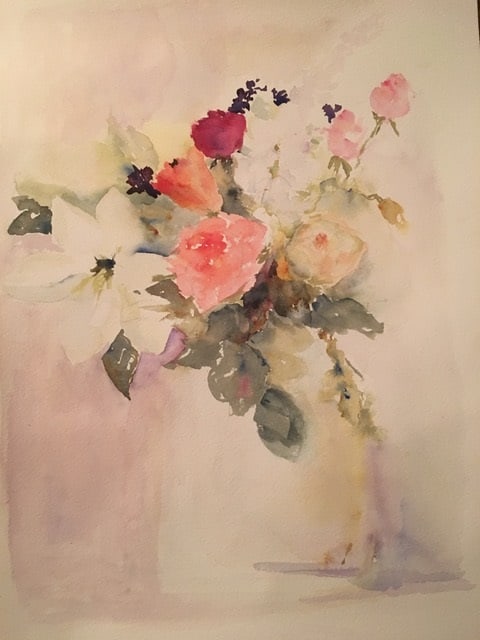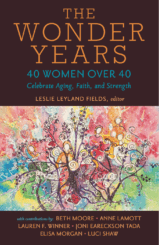
Originally published Jun 26, 2018
I remember the first time I held a watercolor brush in my hand. There was something therapeutic about the weight of it between my fingers, the shape of the brush tapering at the end just so. A brush could carry the load of pigment and water mixed together so its touch released a blush of color onto the paper. I started with one color, a permanent rose, but when it came time to work in the second, Aurelian yellow, my image blotted on the page. I was frustrated. How could I control the spread of color?
My instructor glanced over my shoulder. She was a local artist whose work—loose, free, and transparent—I had admired for years.
“You’re trying to control it too much,” she offered. “It’s okay to let the colors run together. Let the edges get messy. That’s the beauty of it.”
I laid my brush down and looked up at her in tears. “You don’t understand,” I said, “That describes my life right now exactly.”
At that time, Alzheimer’s was clouding my mother’s brain, slowly arresting her ability to think, to communicate, to remember. Mom, previously an outgoing, animated schoolteacher, now had trouble recalling a conversation, or remembering if she had eaten, or that she had been hospitalized for a week with the flu.
Alzheimer’s was clouding my mother’s brain, slowly arresting her ability to think, to communicate, to remember.
“I want to go home,” she would say, after nearly every conversation.
“Mom, you live with us now. We sold your house years ago.”
“Home,” she would repeat. “Home, to the Philippines. I have to take of care my mother.”
As my mother’s Alzheimer’s gradually advanced, simple things like getting her into the car, shuttling her between doctor’s appointments, taking her to adult day care took so much time and patience. I was losing both. I was trying desperately to control things which were out of my control. I was not only caring for my mother, but my four children as well. My heart was guilt-ridden and burdened, caught between allegiance to my teenage children (knowing they would soon be out of the home and gone), and resentment at the consuming needs of my mother.
After awhile, with much reluctance, we brought caregivers into our home, first during the day, then full-time as my mother could not be left alone. It was an extraordinarily messy time, when schedules, demands, and relationships all ran together in a blurry mess. My great escape became the Art Room, the local studio where I took weekly lessons. For those hours every week, the clock stopped. Painting eased the burden of medication schedules, physical therapy routines, and neurology appointments. They all evaporated in the joy of mixing color and creating shapes from pigment and light.
Painting eased the burden of medication schedules, physical therapy routines, and neurology appointments. They all evaporated in the joy of mixing color and creating shapes from pigment and light.
I learned to trust my heart and instincts as I let go. I let the colors on my palette push and shape themselves. I watched as the dark colors illuminated the lighter hues. Painting kept me sane in the midst of my grief, my broken heart, and my weariness.
At home, I suffered through sleepless nights, getting up every two hours to check that my mother hadn’t wandered or fallen. But it wasn’t all difficult. On bright days, we took sidewalk strolls, our arms interlocking. Gradually, though, as the disease progressed, the arm in arm walks became wheelchair rides, often beneath a canopy of oak trees.
My mother is still with me as I write this. Today, I stop when she notices a red geranium, just like the ones she used to have outside her home.
“What flower is that, Mom?” I ask her.
She looks at it and smiles. “Geranium,” she whispers.
A stroke has weakened her voice, her left side, and keeps her mostly bedridden, but on these walks these images bring her joy. She notices the way the shadows drift between the tree branches when the sun is overhead. She notices the flock of crows that call in the bright blue sky. These small things bring a smile to her face, a smile I wish I could capture and tuck into my memory forever.
We stop now to study an old oak tree, the tip of its gnarled branches releasing the first buds of spring. “How does it look?” I ask her.
She peers up at the sky, her small bony fingers grasping the edges of the blanket covering her lap.
“Fresh,” she answers.
She smiles and time stands still. She pushes me to see beauty and wonder in every small thing, as if for the first time. My mother, even in her illness, gives me this gift, this gift of seeing. When I paint, these are the moments I try to capture. A field of sunflowers, a field of lavender. A single bloom, an iris, her favorite. I try to keep the colors pure and vibrant. I try to use brushstrokes that remain fresh and lively, not overworked. For I was holding on, too tightly, to the brush, to mom’s health, to life, afraid to loosen the grip, to lose control of the things I could not control. Now I understand that beauty unfolds in the letting go, in allowing the messy edges to bleed.
My mother, even in her illness, gives me this gift, this gift of seeing.
Ten years have passed since that first art lesson. Ten years have passed since my mother first came to live with us. Mom barely remembers the names of my children anymore. One of my greatest fears is the day she does not remember mine. Sometimes, she plays a game with me. Feigns that she does not remember my name, pauses, then smiles, and spells it out: V-I-N-A.
This week I am working on painting an iris. A single bloom. I am pleased with the shape and the colors. The last stage of a painting is to step back, to create distance, to see it complete. I do not always recall how or why these darks were laid down or why those lights were placed just so. But I have come to trust, finally, that every blot and stroke of color is needed for the whole.
But one thing remains. I put down my brush and choose a pencil. I step near again.
In the corner, I sign my name. V-i-n-a.
Vina Mogg is a daughter, wife, and mother of four. She is in love with God’s creation and loves to paint and watch the sunrise over Mt. Rainer in her homeland of the Pacific Northwest. She is a caregiver and advocate for Alzheimer’s and is a member of the Alz Author’s Association. This essay is taken from The Wonder Years: 40 Women Over 40 on Aging, Faith, Beauty and Strength, edited by Leslie Leyland Fields, and is published here with permission.
is a daughter, wife, and mother of four. She is in love with God’s creation and loves to paint and watch the sunrise over Mt. Rainer in her homeland of the Pacific Northwest. She is a caregiver and advocate for Alzheimer’s and is a member of the Alz Author’s Association. This essay is taken from The Wonder Years: 40 Women Over 40 on Aging, Faith, Beauty and Strength, edited by Leslie Leyland Fields, and is published here with permission.


